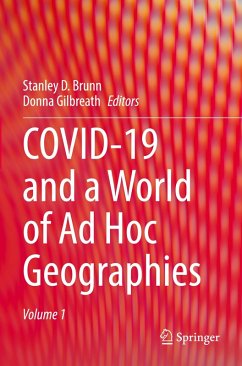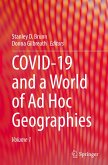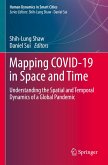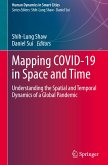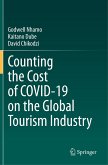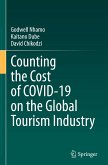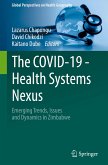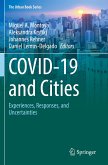COVID-19 and a World of Ad Hoc Geographies
Herausgegeben:Brunn, Stanley D.; Gilbreath, Donna
COVID-19 and a World of Ad Hoc Geographies
Herausgegeben:Brunn, Stanley D.; Gilbreath, Donna
- Broschiertes Buch
- Merkliste
- Auf die Merkliste
- Bewerten Bewerten
- Teilen
- Produkt teilen
- Produkterinnerung
- Produkterinnerung
This book provides an interdisciplinary overview of the causes and impacts of COVID-19 on populations, economies, politics, institutions and environments from all world regions. The book maps the causes, effects and impacts of the virus and describes the impact of the virus on among others health care, teaching and learning, travel, tourism, daily life, local and regional economies, media impacts, elections, and indigenous populations and much more. Contributions to this book come from the humanities, social and policy science disciplines as well as from emerging transdisciplinary fields…mehr
Andere Kunden interessierten sich auch für
![COVID-19 and a World of Ad Hoc Geographies COVID-19 and a World of Ad Hoc Geographies]() COVID-19 and a World of Ad Hoc Geographies161,99 €
COVID-19 and a World of Ad Hoc Geographies161,99 €![Mapping COVID-19 in Space and Time Mapping COVID-19 in Space and Time]() Mapping COVID-19 in Space and Time104,99 €
Mapping COVID-19 in Space and Time104,99 €![Mapping COVID-19 in Space and Time Mapping COVID-19 in Space and Time]() Mapping COVID-19 in Space and Time104,99 €
Mapping COVID-19 in Space and Time104,99 €![Counting the Cost of COVID-19 on the Global Tourism Industry Counting the Cost of COVID-19 on the Global Tourism Industry]() Godwell NhamoCounting the Cost of COVID-19 on the Global Tourism Industry119,99 €
Godwell NhamoCounting the Cost of COVID-19 on the Global Tourism Industry119,99 €![Counting the Cost of COVID-19 on the Global Tourism Industry Counting the Cost of COVID-19 on the Global Tourism Industry]() Godwell NhamoCounting the Cost of COVID-19 on the Global Tourism Industry171,19 €
Godwell NhamoCounting the Cost of COVID-19 on the Global Tourism Industry171,19 €![The COVID-19 - Health Systems Nexus The COVID-19 - Health Systems Nexus]() The COVID-19 - Health Systems Nexus104,99 €
The COVID-19 - Health Systems Nexus104,99 €![COVID-19 and Cities COVID-19 and Cities]() COVID-19 and Cities112,99 €
COVID-19 and Cities112,99 €-
-
-
This book provides an interdisciplinary overview of the causes and impacts of COVID-19 on populations, economies, politics, institutions and environments from all world regions. The book maps the causes, effects and impacts of the virus and describes the impact of the virus on among others health care, teaching and learning, travel, tourism, daily life, local and regional economies, media impacts, elections, and indigenous populations and much more. Contributions to this book come from the humanities, social and policy science disciplines as well as from emerging transdisciplinary fields including climate change, sustainability, health care and epidemiology, security, art, visualization, economic and social well-being, law and borderland studies. As such, this book will be a rich source of information to all those geographers, social scientists and urban and regional planners working in this field.
Hinweis: Dieser Artikel kann nur an eine deutsche Lieferadresse ausgeliefert werden.
Hinweis: Dieser Artikel kann nur an eine deutsche Lieferadresse ausgeliefert werden.
Produktdetails
- Produktdetails
- Verlag: Springer / Springer International Publishing / Springer, Berlin
- Artikelnr. des Verlages: 978-3-030-94351-6
- 1st edition 2022
- Seitenzahl: 2888
- Erscheinungstermin: 17. September 2023
- Englisch
- Abmessung: 235mm x 155mm x 154mm
- Gewicht: 4278g
- ISBN-13: 9783030943516
- ISBN-10: 3030943518
- Artikelnr.: 68633849
- Herstellerkennzeichnung Die Herstellerinformationen sind derzeit nicht verfügbar.
- Verlag: Springer / Springer International Publishing / Springer, Berlin
- Artikelnr. des Verlages: 978-3-030-94351-6
- 1st edition 2022
- Seitenzahl: 2888
- Erscheinungstermin: 17. September 2023
- Englisch
- Abmessung: 235mm x 155mm x 154mm
- Gewicht: 4278g
- ISBN-13: 9783030943516
- ISBN-10: 3030943518
- Artikelnr.: 68633849
- Herstellerkennzeichnung Die Herstellerinformationen sind derzeit nicht verfügbar.
Stanley D. Brunn, Ph.D., is Professor Emeritus in the Department of Geography at the University of Kentucky, Lexington, USA. His research interests cover a broad array of topics within urban geography, economic geography, social geography, information/communications geography, geotechnology and cyberspace, time-space intersections, law, political, and environmental geography, geographical future, as well as disciplinary history. Donna Gilbreath has an MA from the University of Kentucky, Lexington, USA, where she majored in geography and specialized in cartographic techniques. Her interests include public health geography and epidemiology. She also has a graduate certificate in professional and technical writing.
Part 1. Global.- 1. International Boundaries, Biological Borders, and the Public Governance of the COVID-19 Pandemic: Are we Entering a Whole New Era? (Emmanuel Brunet-Jailly).- 2. Pandemic Geopolitics in the Anthropocene (Simon Dalby).- 3. COVID-19 and the Science of where (Michael F. Goodchild).- 4. Coronavirus and Conservation: Environmental Repercussions of the COVID-19 pandemic (Helen D. Hazen).- 5. Pandemic Geopolitics and the Bordering of COVID-19: Academic and Lay Geographies of the Pandemic and Policies to Contain and Mitigate the Novel Coronavirus (Virginie Mamadouh).- 6. Rethinking Distance and Presence Conceptions in Times of COVID-19 and post-COVID-19: The Search for a New Educational Literacy (Paulo Quadros).- Part 2. States, Cities and COVID-19.- 7. The Swedish COVID-19 Enigma/Exception (Sebastian Abrahamsson and Richard Ek).- 8. Insularity in a Connected World? The COVID-19 Pandemic in Iceland (Karl Benediktsson, Benjamin D. Hennig, Anne-Cécile Mermet, and Sigríður Haraldsdóttir).- 9. Impacts of the COVID-19 Pandemic on a Small Island: The Isle of Man Case Study (Sharon C. Cobb).- 10. Medical Philately and the World of COVID-19 Postage Stamps: Issues of Truth, Health and Wealth (Stanley D. Brunn).- 11. The COVID-19 Pandemic in Ukraine: A Mosaic of Regional Patterns and Voices of Social Disparity (Eugenia Maruniak and Olena Dronova).- 12. COVID-19 Policy in Uzbekistan: Slipping Back Toward Authoritarianism? (Reuel Hanks and Dilshod Achilov).- 13. The Pandemic in Belarus in 2020-21: COVID-19 in the Shadow of Politics (Ales Kirkevich and Alena Makouskaya).- 14. COVID-19, the Stay-Home Discourse and a 'New' Geographic Haven (Mohamed Salah Eddine Madiou).- 15. COVID-19 Geopolitics in Southeast Asia: Regional and National Health (in)Securities in Times of Pandemic (Carl Grundy-Warr).- 16. Three Challenges Facing Guatemala's COVID-19 Crisis: Mobility, Violence and Governance (Trudy Mercadal).- 17. COVID-19 Waves and Politics in Costa Rica (Ivan Molina).-18. Societal Perceptions of the Saudi Government's Response to the Coronavirus Pandemic (Mark C. Thompson).- 19. Tackling Challenges of COVID-19: An Assessment of the Convergence-Divergence Debates from the Global South-India (M. Satish Kumar and Aditya Singh).- 20. Health Geography of COVID-19: An Exploratory Analysis of the Pandemic During its First Phase in the Compact Cities of Barcelona and Madrid, Spain (Montserrat Pallares-Barbera, Simón Sánchez-Moral, Rafael Vicente-Salar, and Alfonso Arellano).- 21. Three impacts of COVID-19 in Pakistan society: Home Confinement, Social Survey Data and Maps Showing Diffusion (Tahir Awan, Tehreem Raza Ch, and Mavia Mumtaz).- Part 3. Political impacts: Laws, Borders, Diplomacy, Elections, Peacekeeping.- 22. Peacekeeping Operations: Challenges and Opportunities in the Midst of Health Crises (Jessica Di Salvatore).- 23. Travel Restrictions and Border Security Measures on the Canada-U.S. Border During the COVID-19 Pandemic-Does Law Matter in a Crisis? (Roger S. Fisher).- 24. Forgotten Ones: Rhetoric of Migration and Tourism Governance in South Africa in the Sedentary Epoch of COVID-19 (Samuel Umoh Uwem and Oyewo Adetola Elizabeth).- 25. From European Union Student Mobility to Lockdown: "Virtual Study Mobility" in the COVID-19 Era and a Case Study of Transnational Law in an International Classroom Delivered Online (Cherry James, John Koo, and Emmanouela Mylonaki).- 26. Vaccination Nation: Vaccine Diplomacy and the U.S. Vaccine Rollout (Shaun J. Johnson).- 27. Changing COVID-19 Border Restrictions and Borderland Resilience: The Finnish-Swedish Border Case (Eeva-Kaisa Prokkola and Juha Ridanpää).- 28. Free Movement of Persons and Goods in the European Union During COVID-19 (Lehte Roots).- 29. Intertwined Geographies of the Pandemic and the U.S. Presidential Election of 2020: COVID-19 Prevalence and Donald Trump (Ryan Weichelt, J. Clark Archer, Robert Shepard, Robert Watrel, and Jill Archer).- Part 4. Communication, Branding and the Media.- 30. Affective Immediately: Reading the Semiotic Landscape of COVID-19 in Lincoln, Nebraska (James E. Baker).- 31. Local Newspaper Coverage of the COVID-19 Pandemic in Two Major Texas Cities: A Visual Comparison of Houston and El Paso (Sarah A. Blue and Mary Stycos).- 32. COVID-19 as the Great (un)equalizer: The Framing of Women in Media Coverage in China, the Middle East, and the U.S. (Mari A. DeWees and Amy C. Miller).- 33. Place-Branding for Immigrant and Refugee Integration and Receptivity Amid the COVID-19 Pandemic: Responses of U.S. Cities in the "Welcoming America" Network (Paul N. McDaniel, Rajit H. Das, and Darlene Xiomara Rodriguez).- 34. Lost in Translation: Reporting About COVID-19 Pandemic by Community Vernacular Radio Stations in Rural Kenya (Lilliane Atieno Oloo and Daniel Ochieng' Orwenjo).- 35. Examining Effective Communication during COVID-19 Through Prime Minister's Speeches: The Case of Malaysia (Teresa Wai See Ong).- 36. Trump and the Coronavirus: The Triumph of Incompetence (Barney Warf).- Part 5. Communications: Websites, Social Media.- 37. Presenting, Representing, and Misrepresenting COVID-19 in the five Central Asian States: The Political Underpinnings of Official State Coronavirus Websites in Authoritarian Regimes (Ryan P. Cabana).- 38. The Role of User-Generated Content Data for Collaborative Learning: Identifying Tourism Hot Topics During the Pandemic (Nuria Recuero Virto).- 39. The Impact of COVID-19 and use of Geo-Tagged User Data in Territories without Planning: The Case of São Tomé and Príncipe (Nagayamma Aragão and Carlos Smaniotto Costa).- 40. Social Distancing and Politeness: Hungarian Emailing Practices During the Coronavirus Epidemic (Ágnes Domonkosi and Zsófia Ludányi).- 41. Application of GIS in Vaccine Distribution During COVID-19 (Jing Wu).- Part 6. Cartoons and Cartooning.- 42. More than a Message: Public Health Advocacy, Political Cartooning and COVID-19 Challenges in Pakistan (Ayesha Ashfaq and Joseph Russomanno).- 43. What's so Funny about COVID-19? How some Comic Strip Artists have Approached or Avoided a Sensitive Subject (Thomas L. Bell).- 44. Visualizing the Unspeakable in Thought: A Multi-Model Discourse Analysis of Cartoons as a Device for Communicating (Maxwell Mpotsiah).- Part 7. Maps and Mapping.- 45. One Year of COVID-19: Mapping the Spread of a Global Pandemic (Benjamin D. Hennig).- 46. Mapping Silenced Spaces During Increased Overdose and COVID-19: Opportunities for Danger and Harm Reduction in Southern Appalachia (Lesly-Marie Buer, Bayla Ostrach, Sam Armbruster, and Erin Major).- 47. COVID-19 in Tunisia: Mapping and Documenting the Impacts on those on the Margins (Betty Rouland and Marouen Taleb).- 48. Mapping the COVID-19 Spatial Behaviors and Narratives of Women in an Architecture School in the Midwest USA" (Mania T. Taher).- 49. Increased use of Maps During the COVID-19 pandemic: An example from Morocco (Abdallah Zouhauri).- Part 7. Cultures: Diffusion and Social Well-Being).-50. The Way from the Leading Position to the Last: Geodemographic Analysis of the COVID-19 Pandemic in Czechia (Dagmar Dzúrová, Klára Hulíková Tesárková, Pavlína Netrdová, and Lukás Bruha).- 51. COVID-19 Deaths in México: A Spatiotemporal Analysis (Oscar Gerardo Hernández-Lara, José R. Díaz-Garayúa, and Kevin A. Butler).- 52. Impacts of COVID-19 on Nigerian Culture (Ibrahim Badamasi Lambu).- 53. Research Frontiers on COVID-19 Issues in Brazilian Context (Paulo Quadros).- 54. Geography, Factors and Consequences of COVID-19 Diffusion in Russia (Stepan Zemtsov and Vyacheslav Baburin).- Part 9. Mobility and Immobility.- 55. Effects of COVID-19 on Urban Mobility and Public Space use in Kumasi, Ghana (Clifford Amoako, Kwasi Kwafo Adarkwa, and Michael Poku-Boansi).- 56. Impact of COVID-19 on Nepal's Labour Migration (Sadikshya Bhattarai and Jeevan Baniya).- 57. Voting with their Feet: Coronavirus Pandemic Refugees and the Future of American Cities (James H. Johnson, Jr.).- 58. Exploring Human Mobilities in the COVID-19 Era in Urban and Rural Canada (K. Bruce Newbold, Curtis Towle, and Kaylah Vrabic).- 59. Rearranging Mobilities and Immobilities and Placeremaking During COVID-19: Governing the Pandemic Situation through (im)mobilities in South Korea (HaeRan Shin).- Part 10. Inequalities and Divides).- 60. Pandemic and Education: Persistent Deepening of Educational Inequalities in Argentina as a Consequence of COVID-19 (Gustavo Javier Annessi and Paola Demirta).- 61. COVID-19 and the Comorbidities of Spatial Inequality and Colonial Legacy: Two Caribbean Cases - Jamaica and Trinidad & Tobago (April K. Baptiste and Hubert Devonish).- 62. Digital Inequalities in Times of the COVID-19 Pandemic in Israel and Germany (Elisabeth Sommerlad and Yossi David).- Part 11. Marginalized Groups: Refugees, Silences, Gender, Racism, Survival.- 63. Beyond the Ecumene: Roma Genesis, Community and Survival in the COVID-19 World (Krasimir Asenov).- 64. Ethnic Minorities in Poland in the Face ofthe COVID-19 Pandemic: Threats, Stigma and Forms of (in)visibility (Bartlomiej Chromik, Joanna Maryniak, and Justyna Olko).- 65. Everyday Morbid Geography: Street life and COVID-19 State Regulation in Manila and Hanoi (José Edgardo A. Gomez, Jr., Redento B. Recio, Ha Minh Hai Thai, and Phuong Thu Nguyen).- 66. Undocumented Migrants and the COVID-19 Pandemic: Similar and Dissimilar COVID-19 Stories Comparing Finland and Iran (Jussi S. Jauhiainen and Davood Eyvazlu).- 67. 'If I don't Sell Food, How Would I eat?' Negotiating Street Vendor Livelihoods in the Context of COVID-19 Lockdowns in Urban Thailand, Vietnam, and Laos (Jennifer C. Langill, Binh N. Nguyen, and Sarah Turner).- 68. Impact of COVID-19 on Local Planning Practices: Focusing on Tactical Urbanism, Slow Streets and low-Income Communities in Oakland, Los Angeles, San Francisco, Denver, Chicago, and New York (Joongsub Kim).- 69. Risk and the Transformation of Everyday Places and Spaces: Emptiness and Meaning-Making in Daily Life Amid the COVID-19 Pandemic Hazardscape (DeMond Shondell Miller, Nicola Davis Bivens, Rosalyn D. Harrington, and Anita Bledsoe-Gardner).- 70. Racism in the Times of COVID-19: Angos, Dirty, Undisciplined, and Vendors in Quito, Ecuador (M. Belén Noroña).- 71. Blurry Microgeographies of the New Normal: Grappling with COVID-19 Disruptions, Disgust and Despair in Switzerland (Sven Daniel Wolfe).- 72. Vulnerability, Infection, and Anti-discrimination among Asian Americans and COVID-19: Explorations into Race and Health Intersections in California (Siqiao Xie, Wei Li, and Yining Tan).- 73. Racism, Risk, and Supply: U.S. Policies toward COVID-19 and Asia, and Current and Future Impacts on Asian Americans (Karen J. Leong, Wei Li, and Angela Chia-Chen Chen).- Part 12. Indigenous Groups.- 74. Q'eqaläj Jiq' Ojöb 'Darkest Suffocating Cough' (COVID-19) in Guatemala: Kaqchikel Maya Personal Accounts of Overcoming the Pandemic and its Despair (Ixq'anil Judith M. Maxwell, Ixnal Ambrocia Cuma Chávez, Ixkamey, Magda Silvia Sotz' Mux, Aq'ab'al Gonzalo Ticun Quel, Oxlajuj B'atz' Byron Vinicio Socorec Yucuté, Mokchewan Marco Antonio Guaján Cristal, Lajuj B'atz' Edy Rene Guaján Car).- 75. COVID-19, "Black lives Matter" and Indigenous Australians: A tale of two Intersecting Pandemics (Robyn Newitt and Corrinne T. Sullivan).- 76. Facing Vulnerability and Mobilizing Resilience: Impact of the COVID-19 Pandemic on Speakers of Indigenous Languages in Mexico and their Protective Behaviours (Justyna Olko, Joanna Maryniak, and Bartlomiej Chromik).- Part 13. Economy and Economic Livelihoods.- 77. COVID-19 and the Interruption of Sister Cities Activities: Lexington, Kentucky and its four "Sister" Thoroughbred Raising/Racing Cities (Stanley D. Brunn and Kay Sargent).- 78. Spatial Dimensions of Vulnerability: Meatpacking, Socioeconomics, and the Outbreak of COVID-19 in the High Plains of Texas (Richard C. Jones and Jamie Gillis).- 79. Forecasting the Economic Impacts of COVID-19: A case for the Namibian Economy (Evelina Julius, Samuel Nuugulu, and Lukas Julius).- 80. Impact of COVID-19 on the Dutch Flower Trade-Logistics Node (Melika Levelt and Abdel El Makhloufi).- 81. Meeting the Challenge of COVID-19: How American Craft Breweries Responded (Neil Reid, Margaret Gripshover, and Thomas L. Bell).- 82. How Work and Shopping Related Travel Changed during the COVID-19 Pandemic in Western Hungary in 2020 (Viktória Szöke and László Kovács).- 83. The Italian Fashion Industry facing the COVID-19 Pandemic Crisis (Tania Toffanin).- 84. Resilience of Retailing: From the Perspective of Chinese Daily Shopping Distance in Three Stages Related to the COVID-19 Pandemic (Shangyi Zhou and Ruizhe Hong).- 85. Stability Extension of Food Culture Space: A Case Study of Consumer Space Practice Before and After COVID-19 Epidemic in Wuhan Food Markets (Yilin Gan, Yuanyuan Zhu, and Jing Luo).- Part 14. Rural: Farming, Fishing and Small Town Life, Livelihoods and Health Care.- 86. Rural Livelihoods Amidst the COVID-19 Pandemic: Farmers and Fishers in Thailand and Vietnam (Edo Andriesse, Quynh T. N. Pham, Thu L. T. Dinh, Chaturong Kongkaew, Adirake Markphol, and Jawanit Kittitornkool).- 87. Reflections on COVID-19 and its Impact on Marginal Urban Places: The Case of Four Small Towns in the Western Cape, South Africa (Ronnie Donaldson, Jessica Eichhoff, Franky Nightingale, Jamie Cloete, Masixole Ndamandama, Geo Erasmus).- 88. Effects of the COVID-19 Pandemic on the U.S. Custom Grain and Forage Harvesting Labor Supply and 2020 Harvest (Jason P. Holcomb).- 89. The COVID-19 Pandemic and Coastal Fishery Livelihood Systems: Socio-Economic Implications for Small-Scale Fisherfolk in Winneba, Ghana (Victor Owusu, Yaw Agyeman Boafo, Moses Adjei, and Richard Boateng).- 90. Reflections of a Nurse/Administrator during COVID-19: Preparedness and Fear in Rural Kentucky Nursing Homes (Donna Gilbreath and Linda McConnell, RN, LNHA).- Part 15. Sports.- 91. Life in the National Basketball Association Bubble: A Space for Social Justice During the COVID-19 Pandemic (Neil Conner).- 92. Futures of Change and Futures of Uncertainty: The Impacts of COVID-19 and Movements for Racial Justice in English Football and NASCAR (Michael Hawkins).- 93. Change the Game: Sport and Leisure Responses to COVID-19 (Catherine A. Waite).- Part 16. Tourism and Travel.- 94. COVID-19 Pandemic and Young Tourists' Travel Risk Perceptions: Impacts on Travel Restrictions (local and International) and Tourism (Aleksandra S. Dragin, Maja B. Mijatov, Nebojsa Majstorovic, Bojan Janicic, and Darinka Korovljev).- 95. Challenges of the COVID-19 Pandemic Confront Georgia's Tourism Industry (Giorgi Gogsadze, Nino Pavliashvili, Mariam Tsitsagi, and Nana Kvirkvelia).- 96. Corporate Social Responsibility in Times of Epidemic Outbreaks: A Case Study from the Hospitality Industry in Spain (Thais González-Torres and José Luis Rodríguez-Sánchez).- 97. How COVID-19 Changed Mobility: A Life-Oriented Approach to Travel Behavior Changein Flanders, Belgium (Hannah Hook, Jonas de Vos, Veronique Van Acker, and Frank Witlox).- 98. Finland's Tourism in the Times of the COVID-19 Pandemic: Abrupt Halt in Internationals and Moderate Revival of Domestics (Tommi Inkinen).- 99. Measuring the Spread of COVID-19: Restrictions and Mobility in the Visegrad Countries (Czech Republic, Hungary, Poland, Slovakia) (Radoslav Klamár, Miloslav Michalko, and Jana Michalková).- 100. Emerging Technocratic Cosmologies on Traveling: Travels and Tourism after COVID-19 in Argentina (Maximilliano E. Korstanje).- 101. Impacts of COVID-19 on Youth Tourism and Hospitality Managers in Training in Serbia (Maja B. Mijatov, Aleksandra S. Dragin, Nebojsa Majstorovic, Bojan Janicic, and Zrinka Zadel).- 102. Tourism and COVID-19: Socio-Economic Impacts of COVID-19 on the Tourism Industry in Bulgaria (Desislava Varadzhakova, Aleksandra Ravnachka, and Nikola Naumov).- 103. COVID-19 and Tourism Geography at a Crossroads: Challenges, Opportunities and Moving Forward (Velvet Nelson).- Part 17. Arts: Photography, art, Film, Music and Architecture.- 104. Impacts of the COVID-19 Pandemic on Live Musical Performance in the United States and the United Kingdom: Outsider and Insider Perspectives (Thomas L. Bell, Brian Bell, and Carl Taylor).- 105. The Bigger Picture: Coronavirus in the Context of the History of the American Film Industry (Kevin J. Corbett).- 106. Songs which Resonate: Music and Nostalgia in the First U.K. COVID-19 Lockdown (Georgina Hughes).- 107. #artcovidbn on Instagram: Capturing COVID-19's new Normal in Brunei via Creative Artwork (Siti Mazidah Mohamad and Nurul Farzana Abdul Ghafar).- 108. Photographing COVID-19 on the Philadelphia Landscape: Responses, Realities, Silences, and Reactions (Rickie Sanders).- 109. "Stay at home:" Pictorial Reflections of Polish Students During the COVID-19 Pandemic (Agnieszka Swietek, Tomasz Padlo, and Joanna Nowocien).- Part 18. Education: Teaching and Learning.- 110. Education as "Mental Vaccine:" Designing Educational Materials about COVID-19 (Philip J. Gersmehl and Carol A. Gersmehl).- 111. Perceived Impacts of COVID-19 by Spanish University Students: Changes in the Physical and Social Environments (Antonio Manuel Ávila Muñoz, Inmaculada Clotilde Santos Díaz, and Ester Trigo Ibáñez).- 112. Online Education: An Unprepared Effort Posing Challenges to Students and Teachers of the Punjab State of India amid COVID-19 (Nishant Juneja, Kulbhushan Agnihotri, and Harleen Kaur).- 113. Social Consequences of the COVID-19 Pandemic on the School Closings in five Southern Africa Countries: Lesotho, Namibia, South Africa, Zambia, and Zimbabwe (Michael M. Kretzer).- 114. Effect of COVID-19 Lockdown on Higher Education: Challenges Facing Engineering Education in India (Sunil Jayant Kulkarni).- 115. From Emergency Remote Teaching to Academic Strategic Digitalization Planning: How a College Responded to COVID-19 and what Departments Need to Consider Implementing (Chris Lukinbeal).- 116. TheLandscape of Medical Translators and Interpreters During the Coronavirus Pandemic: Terminology, Deontology and Teaching-Learning Resources from the Translation Studies Perspective (English, French, Spanish) (Maria Carmen López-Ruiz).- 117. (Re)defining the Teaching-Learning Process during COVID-19 Pandemic: The Portuguese Experience (Laura Soares and Elsa Pacheco).- 118. Teaching Geography in the Midst of the COVID-19 Pandemic in a Chinese University: A Case Study of Beijing Normal University (Huasheng Zhu, Hao Wang, Jing Liu, and Shiyang Li).- 119. Teaching about the Geography of COVID-19 in High Schools in Different Neighborhoods in Adana, Turkey: Assessments of Teaching Outcomes and Student Learning (Çigdem Çelik Sahin).- Part 19. Environmental Change, Risk, Sustainability, Conservation and the Bio/Geopolitics.- 120. Prospective Aquatic Brandscaping Megaproject Addressing Climate Change and Coronavirus of the Coastal Californias: The Intersection of Natural and Anthropic 2020 AD Impacts (Richard B. Cathcart and Charles W. Finkl).- 121. Costa Rican Sustainable Development Perspectives: The COVID-19 Pandemic as a Turning Point? (Edgar Espinoza-Cisneros, Ana María Araya-Castro, and Daniel Gutiérrez-González).- 122. Risk Perception Management Related to COVID-19: A Study of Scenario Planning in Cuba (Silvia M. Pell del Río, Alfredo L. Gil Rodríguez, D. Valdés Santiago, and Maria M. Febles Elejalde).- 123. Zoos in Canada: Responses to COVID-19 pandemic (Paul J. Harpley).- 124. Shared Spaces, Shared Suffering: Exploring the Effects of COVID-19 on Urban Animal Advocacy Organizations in Chicago and Kansas City, USA (Julie L. Urbanik and Connie L. Johnston).- 125. Animal Geographies in the Time of COVID-19: Challenges and Opportunities (Julie Urbanik and Alice J. Hovorka).- 126. The COVID-19 Pandemic and Bio/Geopolitics in Japan (Takashi Yamazaki).- Part 20. Language and linguistics.- 127. Fading Voices: COVID-19, Language Death and the Case of Bergamasco in Italy (Simone De Cia and Giovanni Villa).- 128. Persistence of Ethnic and Linguistic Division During the COVID-19 Pandemic Outbreak in Kosovo (Uranela Demaj and Mieke Vandenbroucke).- 129. The Effect of Face Mask on the Acoustic Properties of Vowels (Georgios P. Georgiou).- 130. The Heterogeneity of Language Policies and its Related Health Crisis Communication about COVID-19 in Lesotho and South Africa (Michael M. Kretzer and Verbra Pfeiffer).- 131. 'No Face Mask, no Entry!': Dissecting Multilingual COVID-19 Related Public Health Signs in Penang, Malaysia (Teresa Wai See Ong).- 132. Explaining COVID-19-Related Concepts in Singapore: A Minimal Language Approach (Jock Wong).- Part 21. Religion and Faith Communities.- 133. Faith Communities Contribute to COVID-19 Relief: Global and Local Responses of Churches Belonging to a World Communion in Accompaniment with the Evangelical Lutheran Church in America (Rebecca Duerst, Gustavo Driau, Anne Ruedisili Langdji, and Chandran Martin).- 134. Perspectives on the Role of Mysticism as an Inter-Religious Meta-Narrative in the Context of the COVID-19 Pandemic (Dorthe Enger).- 135. How do Arab and Moslem Countries and Communities act in Dealing with the Impacts of the COVID-19 Pandemic? (Ghazi-Walid Falah and Ahmad Ben Touq).- 136. Response to the COVID-19 Pandemic by the Hindu Faithbased Organizations in Lucknow, Uttar Pradesh, India (Priyanka Ghosh and Swati Joshi).- Part 22. Coronavirus, Faith-based Communities, Hindu, Religion, Service, India.- 137. Narrative Geographies of the Coronavirus: Cultural Interdependencies and the Emergence of new Assemblages (Dawn R. Gilpin and Rian Bosse).- 138. Immediate Urgency and Broad Agreement: Early Public COVID-19 Responses of Religiously Affiliated Nongovernmental Organizations (Karsten Lehmann).- 139. An Unequal Pandemic: Migration, the Hajj, and Hypernationalism in Saudi Arabia (Saurabh Mishra).- 140. Orthodox Jewish Communities and COVID-19: At the Interface of Faith, Medicine and Technology (David Newman).- 141. Retrenchment and Retreat: Policy Changes in the Time of COVID-19 for The Church of Jesus Christ of Latter-day Saints (J. Matthew Shumway and Laurie Weisler).- Part 23. Organizations, Resources and Research Challenges.- 142. Special Libraries in the Time of COVID-19: A Time for Refining, Redefining and Rethinking Missions (Marcy Bidney).- 143. American Association of Geographers' Response to the COVID-19 Crisis (David H. Kaplan and Gary M. Langham).- 144. Subjunctive Geographies: The Contribution of Institutionalised Geography in the German-Speaking Countries to COVID-19 Research (Gert W. Wolf).- 145. The COVID-19 Pandemic and the International Geographical Union (Caichun Yin, Michael E. Meadows, Yi Han, and Wenwu Zhao).- 146. Researching China During the COVID-19 pandemic (Max D. Woodworth, Xuefei Ren, Jesse Rodenbiker, Ettore Santi, Yining Tan, Li Zhang, and Yu Zhou).
Part 1. Global.- 1. International Boundaries, Biological Borders, and the Public Governance of the COVID-19 Pandemic: Are we Entering a Whole New Era? (Emmanuel Brunet-Jailly).- 2. Pandemic Geopolitics in the Anthropocene (Simon Dalby).- 3. COVID-19 and the Science of where (Michael F. Goodchild).- 4. Coronavirus and Conservation: Environmental Repercussions of the COVID-19 pandemic (Helen D. Hazen).- 5. Pandemic Geopolitics and the Bordering of COVID-19: Academic and Lay Geographies of the Pandemic and Policies to Contain and Mitigate the Novel Coronavirus (Virginie Mamadouh).- 6. Rethinking Distance and Presence Conceptions in Times of COVID-19 and post-COVID-19: The Search for a New Educational Literacy (Paulo Quadros).- Part 2. States, Cities and COVID-19.- 7. The Swedish COVID-19 Enigma/Exception (Sebastian Abrahamsson and Richard Ek).- 8. Insularity in a Connected World? The COVID-19 Pandemic in Iceland (Karl Benediktsson, Benjamin D. Hennig, Anne-Cécile Mermet, and Sigríður Haraldsdóttir).- 9. Impacts of the COVID-19 Pandemic on a Small Island: The Isle of Man Case Study (Sharon C. Cobb).- 10. Medical Philately and the World of COVID-19 Postage Stamps: Issues of Truth, Health and Wealth (Stanley D. Brunn).- 11. The COVID-19 Pandemic in Ukraine: A Mosaic of Regional Patterns and Voices of Social Disparity (Eugenia Maruniak and Olena Dronova).- 12. COVID-19 Policy in Uzbekistan: Slipping Back Toward Authoritarianism? (Reuel Hanks and Dilshod Achilov).- 13. The Pandemic in Belarus in 2020-21: COVID-19 in the Shadow of Politics (Ales Kirkevich and Alena Makouskaya).- 14. COVID-19, the Stay-Home Discourse and a 'New' Geographic Haven (Mohamed Salah Eddine Madiou).- 15. COVID-19 Geopolitics in Southeast Asia: Regional and National Health (in)Securities in Times of Pandemic (Carl Grundy-Warr).- 16. Three Challenges Facing Guatemala's COVID-19 Crisis: Mobility, Violence and Governance (Trudy Mercadal).- 17. COVID-19 Waves and Politics in Costa Rica (Ivan Molina).-18. Societal Perceptions of the Saudi Government's Response to the Coronavirus Pandemic (Mark C. Thompson).- 19. Tackling Challenges of COVID-19: An Assessment of the Convergence-Divergence Debates from the Global South-India (M. Satish Kumar and Aditya Singh).- 20. Health Geography of COVID-19: An Exploratory Analysis of the Pandemic During its First Phase in the Compact Cities of Barcelona and Madrid, Spain (Montserrat Pallares-Barbera, Simón Sánchez-Moral, Rafael Vicente-Salar, and Alfonso Arellano).- 21. Three impacts of COVID-19 in Pakistan society: Home Confinement, Social Survey Data and Maps Showing Diffusion (Tahir Awan, Tehreem Raza Ch, and Mavia Mumtaz).- Part 3. Political impacts: Laws, Borders, Diplomacy, Elections, Peacekeeping.- 22. Peacekeeping Operations: Challenges and Opportunities in the Midst of Health Crises (Jessica Di Salvatore).- 23. Travel Restrictions and Border Security Measures on the Canada-U.S. Border During the COVID-19 Pandemic-Does Law Matter in a Crisis? (Roger S. Fisher).- 24. Forgotten Ones: Rhetoric of Migration and Tourism Governance in South Africa in the Sedentary Epoch of COVID-19 (Samuel Umoh Uwem and Oyewo Adetola Elizabeth).- 25. From European Union Student Mobility to Lockdown: "Virtual Study Mobility" in the COVID-19 Era and a Case Study of Transnational Law in an International Classroom Delivered Online (Cherry James, John Koo, and Emmanouela Mylonaki).- 26. Vaccination Nation: Vaccine Diplomacy and the U.S. Vaccine Rollout (Shaun J. Johnson).- 27. Changing COVID-19 Border Restrictions and Borderland Resilience: The Finnish-Swedish Border Case (Eeva-Kaisa Prokkola and Juha Ridanpää).- 28. Free Movement of Persons and Goods in the European Union During COVID-19 (Lehte Roots).- 29. Intertwined Geographies of the Pandemic and the U.S. Presidential Election of 2020: COVID-19 Prevalence and Donald Trump (Ryan Weichelt, J. Clark Archer, Robert Shepard, Robert Watrel, and Jill Archer).- Part 4. Communication, Branding and the Media.- 30. Affective Immediately: Reading the Semiotic Landscape of COVID-19 in Lincoln, Nebraska (James E. Baker).- 31. Local Newspaper Coverage of the COVID-19 Pandemic in Two Major Texas Cities: A Visual Comparison of Houston and El Paso (Sarah A. Blue and Mary Stycos).- 32. COVID-19 as the Great (un)equalizer: The Framing of Women in Media Coverage in China, the Middle East, and the U.S. (Mari A. DeWees and Amy C. Miller).- 33. Place-Branding for Immigrant and Refugee Integration and Receptivity Amid the COVID-19 Pandemic: Responses of U.S. Cities in the "Welcoming America" Network (Paul N. McDaniel, Rajit H. Das, and Darlene Xiomara Rodriguez).- 34. Lost in Translation: Reporting About COVID-19 Pandemic by Community Vernacular Radio Stations in Rural Kenya (Lilliane Atieno Oloo and Daniel Ochieng' Orwenjo).- 35. Examining Effective Communication during COVID-19 Through Prime Minister's Speeches: The Case of Malaysia (Teresa Wai See Ong).- 36. Trump and the Coronavirus: The Triumph of Incompetence (Barney Warf).- Part 5. Communications: Websites, Social Media.- 37. Presenting, Representing, and Misrepresenting COVID-19 in the five Central Asian States: The Political Underpinnings of Official State Coronavirus Websites in Authoritarian Regimes (Ryan P. Cabana).- 38. The Role of User-Generated Content Data for Collaborative Learning: Identifying Tourism Hot Topics During the Pandemic (Nuria Recuero Virto).- 39. The Impact of COVID-19 and use of Geo-Tagged User Data in Territories without Planning: The Case of São Tomé and Príncipe (Nagayamma Aragão and Carlos Smaniotto Costa).- 40. Social Distancing and Politeness: Hungarian Emailing Practices During the Coronavirus Epidemic (Ágnes Domonkosi and Zsófia Ludányi).- 41. Application of GIS in Vaccine Distribution During COVID-19 (Jing Wu).- Part 6. Cartoons and Cartooning.- 42. More than a Message: Public Health Advocacy, Political Cartooning and COVID-19 Challenges in Pakistan (Ayesha Ashfaq and Joseph Russomanno).- 43. What's so Funny about COVID-19? How some Comic Strip Artists have Approached or Avoided a Sensitive Subject (Thomas L. Bell).- 44. Visualizing the Unspeakable in Thought: A Multi-Model Discourse Analysis of Cartoons as a Device for Communicating (Maxwell Mpotsiah).- Part 7. Maps and Mapping.- 45. One Year of COVID-19: Mapping the Spread of a Global Pandemic (Benjamin D. Hennig).- 46. Mapping Silenced Spaces During Increased Overdose and COVID-19: Opportunities for Danger and Harm Reduction in Southern Appalachia (Lesly-Marie Buer, Bayla Ostrach, Sam Armbruster, and Erin Major).- 47. COVID-19 in Tunisia: Mapping and Documenting the Impacts on those on the Margins (Betty Rouland and Marouen Taleb).- 48. Mapping the COVID-19 Spatial Behaviors and Narratives of Women in an Architecture School in the Midwest USA" (Mania T. Taher).- 49. Increased use of Maps During the COVID-19 pandemic: An example from Morocco (Abdallah Zouhauri).- Part 7. Cultures: Diffusion and Social Well-Being).-50. The Way from the Leading Position to the Last: Geodemographic Analysis of the COVID-19 Pandemic in Czechia (Dagmar Dzúrová, Klára Hulíková Tesárková, Pavlína Netrdová, and Lukás Bruha).- 51. COVID-19 Deaths in México: A Spatiotemporal Analysis (Oscar Gerardo Hernández-Lara, José R. Díaz-Garayúa, and Kevin A. Butler).- 52. Impacts of COVID-19 on Nigerian Culture (Ibrahim Badamasi Lambu).- 53. Research Frontiers on COVID-19 Issues in Brazilian Context (Paulo Quadros).- 54. Geography, Factors and Consequences of COVID-19 Diffusion in Russia (Stepan Zemtsov and Vyacheslav Baburin).- Part 9. Mobility and Immobility.- 55. Effects of COVID-19 on Urban Mobility and Public Space use in Kumasi, Ghana (Clifford Amoako, Kwasi Kwafo Adarkwa, and Michael Poku-Boansi).- 56. Impact of COVID-19 on Nepal's Labour Migration (Sadikshya Bhattarai and Jeevan Baniya).- 57. Voting with their Feet: Coronavirus Pandemic Refugees and the Future of American Cities (James H. Johnson, Jr.).- 58. Exploring Human Mobilities in the COVID-19 Era in Urban and Rural Canada (K. Bruce Newbold, Curtis Towle, and Kaylah Vrabic).- 59. Rearranging Mobilities and Immobilities and Placeremaking During COVID-19: Governing the Pandemic Situation through (im)mobilities in South Korea (HaeRan Shin).- Part 10. Inequalities and Divides).- 60. Pandemic and Education: Persistent Deepening of Educational Inequalities in Argentina as a Consequence of COVID-19 (Gustavo Javier Annessi and Paola Demirta).- 61. COVID-19 and the Comorbidities of Spatial Inequality and Colonial Legacy: Two Caribbean Cases - Jamaica and Trinidad & Tobago (April K. Baptiste and Hubert Devonish).- 62. Digital Inequalities in Times of the COVID-19 Pandemic in Israel and Germany (Elisabeth Sommerlad and Yossi David).- Part 11. Marginalized Groups: Refugees, Silences, Gender, Racism, Survival.- 63. Beyond the Ecumene: Roma Genesis, Community and Survival in the COVID-19 World (Krasimir Asenov).- 64. Ethnic Minorities in Poland in the Face ofthe COVID-19 Pandemic: Threats, Stigma and Forms of (in)visibility (Bartlomiej Chromik, Joanna Maryniak, and Justyna Olko).- 65. Everyday Morbid Geography: Street life and COVID-19 State Regulation in Manila and Hanoi (José Edgardo A. Gomez, Jr., Redento B. Recio, Ha Minh Hai Thai, and Phuong Thu Nguyen).- 66. Undocumented Migrants and the COVID-19 Pandemic: Similar and Dissimilar COVID-19 Stories Comparing Finland and Iran (Jussi S. Jauhiainen and Davood Eyvazlu).- 67. 'If I don't Sell Food, How Would I eat?' Negotiating Street Vendor Livelihoods in the Context of COVID-19 Lockdowns in Urban Thailand, Vietnam, and Laos (Jennifer C. Langill, Binh N. Nguyen, and Sarah Turner).- 68. Impact of COVID-19 on Local Planning Practices: Focusing on Tactical Urbanism, Slow Streets and low-Income Communities in Oakland, Los Angeles, San Francisco, Denver, Chicago, and New York (Joongsub Kim).- 69. Risk and the Transformation of Everyday Places and Spaces: Emptiness and Meaning-Making in Daily Life Amid the COVID-19 Pandemic Hazardscape (DeMond Shondell Miller, Nicola Davis Bivens, Rosalyn D. Harrington, and Anita Bledsoe-Gardner).- 70. Racism in the Times of COVID-19: Angos, Dirty, Undisciplined, and Vendors in Quito, Ecuador (M. Belén Noroña).- 71. Blurry Microgeographies of the New Normal: Grappling with COVID-19 Disruptions, Disgust and Despair in Switzerland (Sven Daniel Wolfe).- 72. Vulnerability, Infection, and Anti-discrimination among Asian Americans and COVID-19: Explorations into Race and Health Intersections in California (Siqiao Xie, Wei Li, and Yining Tan).- 73. Racism, Risk, and Supply: U.S. Policies toward COVID-19 and Asia, and Current and Future Impacts on Asian Americans (Karen J. Leong, Wei Li, and Angela Chia-Chen Chen).- Part 12. Indigenous Groups.- 74. Q'eqaläj Jiq' Ojöb 'Darkest Suffocating Cough' (COVID-19) in Guatemala: Kaqchikel Maya Personal Accounts of Overcoming the Pandemic and its Despair (Ixq'anil Judith M. Maxwell, Ixnal Ambrocia Cuma Chávez, Ixkamey, Magda Silvia Sotz' Mux, Aq'ab'al Gonzalo Ticun Quel, Oxlajuj B'atz' Byron Vinicio Socorec Yucuté, Mokchewan Marco Antonio Guaján Cristal, Lajuj B'atz' Edy Rene Guaján Car).- 75. COVID-19, "Black lives Matter" and Indigenous Australians: A tale of two Intersecting Pandemics (Robyn Newitt and Corrinne T. Sullivan).- 76. Facing Vulnerability and Mobilizing Resilience: Impact of the COVID-19 Pandemic on Speakers of Indigenous Languages in Mexico and their Protective Behaviours (Justyna Olko, Joanna Maryniak, and Bartlomiej Chromik).- Part 13. Economy and Economic Livelihoods.- 77. COVID-19 and the Interruption of Sister Cities Activities: Lexington, Kentucky and its four "Sister" Thoroughbred Raising/Racing Cities (Stanley D. Brunn and Kay Sargent).- 78. Spatial Dimensions of Vulnerability: Meatpacking, Socioeconomics, and the Outbreak of COVID-19 in the High Plains of Texas (Richard C. Jones and Jamie Gillis).- 79. Forecasting the Economic Impacts of COVID-19: A case for the Namibian Economy (Evelina Julius, Samuel Nuugulu, and Lukas Julius).- 80. Impact of COVID-19 on the Dutch Flower Trade-Logistics Node (Melika Levelt and Abdel El Makhloufi).- 81. Meeting the Challenge of COVID-19: How American Craft Breweries Responded (Neil Reid, Margaret Gripshover, and Thomas L. Bell).- 82. How Work and Shopping Related Travel Changed during the COVID-19 Pandemic in Western Hungary in 2020 (Viktória Szöke and László Kovács).- 83. The Italian Fashion Industry facing the COVID-19 Pandemic Crisis (Tania Toffanin).- 84. Resilience of Retailing: From the Perspective of Chinese Daily Shopping Distance in Three Stages Related to the COVID-19 Pandemic (Shangyi Zhou and Ruizhe Hong).- 85. Stability Extension of Food Culture Space: A Case Study of Consumer Space Practice Before and After COVID-19 Epidemic in Wuhan Food Markets (Yilin Gan, Yuanyuan Zhu, and Jing Luo).- Part 14. Rural: Farming, Fishing and Small Town Life, Livelihoods and Health Care.- 86. Rural Livelihoods Amidst the COVID-19 Pandemic: Farmers and Fishers in Thailand and Vietnam (Edo Andriesse, Quynh T. N. Pham, Thu L. T. Dinh, Chaturong Kongkaew, Adirake Markphol, and Jawanit Kittitornkool).- 87. Reflections on COVID-19 and its Impact on Marginal Urban Places: The Case of Four Small Towns in the Western Cape, South Africa (Ronnie Donaldson, Jessica Eichhoff, Franky Nightingale, Jamie Cloete, Masixole Ndamandama, Geo Erasmus).- 88. Effects of the COVID-19 Pandemic on the U.S. Custom Grain and Forage Harvesting Labor Supply and 2020 Harvest (Jason P. Holcomb).- 89. The COVID-19 Pandemic and Coastal Fishery Livelihood Systems: Socio-Economic Implications for Small-Scale Fisherfolk in Winneba, Ghana (Victor Owusu, Yaw Agyeman Boafo, Moses Adjei, and Richard Boateng).- 90. Reflections of a Nurse/Administrator during COVID-19: Preparedness and Fear in Rural Kentucky Nursing Homes (Donna Gilbreath and Linda McConnell, RN, LNHA).- Part 15. Sports.- 91. Life in the National Basketball Association Bubble: A Space for Social Justice During the COVID-19 Pandemic (Neil Conner).- 92. Futures of Change and Futures of Uncertainty: The Impacts of COVID-19 and Movements for Racial Justice in English Football and NASCAR (Michael Hawkins).- 93. Change the Game: Sport and Leisure Responses to COVID-19 (Catherine A. Waite).- Part 16. Tourism and Travel.- 94. COVID-19 Pandemic and Young Tourists' Travel Risk Perceptions: Impacts on Travel Restrictions (local and International) and Tourism (Aleksandra S. Dragin, Maja B. Mijatov, Nebojsa Majstorovic, Bojan Janicic, and Darinka Korovljev).- 95. Challenges of the COVID-19 Pandemic Confront Georgia's Tourism Industry (Giorgi Gogsadze, Nino Pavliashvili, Mariam Tsitsagi, and Nana Kvirkvelia).- 96. Corporate Social Responsibility in Times of Epidemic Outbreaks: A Case Study from the Hospitality Industry in Spain (Thais González-Torres and José Luis Rodríguez-Sánchez).- 97. How COVID-19 Changed Mobility: A Life-Oriented Approach to Travel Behavior Changein Flanders, Belgium (Hannah Hook, Jonas de Vos, Veronique Van Acker, and Frank Witlox).- 98. Finland's Tourism in the Times of the COVID-19 Pandemic: Abrupt Halt in Internationals and Moderate Revival of Domestics (Tommi Inkinen).- 99. Measuring the Spread of COVID-19: Restrictions and Mobility in the Visegrad Countries (Czech Republic, Hungary, Poland, Slovakia) (Radoslav Klamár, Miloslav Michalko, and Jana Michalková).- 100. Emerging Technocratic Cosmologies on Traveling: Travels and Tourism after COVID-19 in Argentina (Maximilliano E. Korstanje).- 101. Impacts of COVID-19 on Youth Tourism and Hospitality Managers in Training in Serbia (Maja B. Mijatov, Aleksandra S. Dragin, Nebojsa Majstorovic, Bojan Janicic, and Zrinka Zadel).- 102. Tourism and COVID-19: Socio-Economic Impacts of COVID-19 on the Tourism Industry in Bulgaria (Desislava Varadzhakova, Aleksandra Ravnachka, and Nikola Naumov).- 103. COVID-19 and Tourism Geography at a Crossroads: Challenges, Opportunities and Moving Forward (Velvet Nelson).- Part 17. Arts: Photography, art, Film, Music and Architecture.- 104. Impacts of the COVID-19 Pandemic on Live Musical Performance in the United States and the United Kingdom: Outsider and Insider Perspectives (Thomas L. Bell, Brian Bell, and Carl Taylor).- 105. The Bigger Picture: Coronavirus in the Context of the History of the American Film Industry (Kevin J. Corbett).- 106. Songs which Resonate: Music and Nostalgia in the First U.K. COVID-19 Lockdown (Georgina Hughes).- 107. #artcovidbn on Instagram: Capturing COVID-19's new Normal in Brunei via Creative Artwork (Siti Mazidah Mohamad and Nurul Farzana Abdul Ghafar).- 108. Photographing COVID-19 on the Philadelphia Landscape: Responses, Realities, Silences, and Reactions (Rickie Sanders).- 109. "Stay at home:" Pictorial Reflections of Polish Students During the COVID-19 Pandemic (Agnieszka Swietek, Tomasz Padlo, and Joanna Nowocien).- Part 18. Education: Teaching and Learning.- 110. Education as "Mental Vaccine:" Designing Educational Materials about COVID-19 (Philip J. Gersmehl and Carol A. Gersmehl).- 111. Perceived Impacts of COVID-19 by Spanish University Students: Changes in the Physical and Social Environments (Antonio Manuel Ávila Muñoz, Inmaculada Clotilde Santos Díaz, and Ester Trigo Ibáñez).- 112. Online Education: An Unprepared Effort Posing Challenges to Students and Teachers of the Punjab State of India amid COVID-19 (Nishant Juneja, Kulbhushan Agnihotri, and Harleen Kaur).- 113. Social Consequences of the COVID-19 Pandemic on the School Closings in five Southern Africa Countries: Lesotho, Namibia, South Africa, Zambia, and Zimbabwe (Michael M. Kretzer).- 114. Effect of COVID-19 Lockdown on Higher Education: Challenges Facing Engineering Education in India (Sunil Jayant Kulkarni).- 115. From Emergency Remote Teaching to Academic Strategic Digitalization Planning: How a College Responded to COVID-19 and what Departments Need to Consider Implementing (Chris Lukinbeal).- 116. TheLandscape of Medical Translators and Interpreters During the Coronavirus Pandemic: Terminology, Deontology and Teaching-Learning Resources from the Translation Studies Perspective (English, French, Spanish) (Maria Carmen López-Ruiz).- 117. (Re)defining the Teaching-Learning Process during COVID-19 Pandemic: The Portuguese Experience (Laura Soares and Elsa Pacheco).- 118. Teaching Geography in the Midst of the COVID-19 Pandemic in a Chinese University: A Case Study of Beijing Normal University (Huasheng Zhu, Hao Wang, Jing Liu, and Shiyang Li).- 119. Teaching about the Geography of COVID-19 in High Schools in Different Neighborhoods in Adana, Turkey: Assessments of Teaching Outcomes and Student Learning (Çigdem Çelik Sahin).- Part 19. Environmental Change, Risk, Sustainability, Conservation and the Bio/Geopolitics.- 120. Prospective Aquatic Brandscaping Megaproject Addressing Climate Change and Coronavirus of the Coastal Californias: The Intersection of Natural and Anthropic 2020 AD Impacts (Richard B. Cathcart and Charles W. Finkl).- 121. Costa Rican Sustainable Development Perspectives: The COVID-19 Pandemic as a Turning Point? (Edgar Espinoza-Cisneros, Ana María Araya-Castro, and Daniel Gutiérrez-González).- 122. Risk Perception Management Related to COVID-19: A Study of Scenario Planning in Cuba (Silvia M. Pell del Río, Alfredo L. Gil Rodríguez, D. Valdés Santiago, and Maria M. Febles Elejalde).- 123. Zoos in Canada: Responses to COVID-19 pandemic (Paul J. Harpley).- 124. Shared Spaces, Shared Suffering: Exploring the Effects of COVID-19 on Urban Animal Advocacy Organizations in Chicago and Kansas City, USA (Julie L. Urbanik and Connie L. Johnston).- 125. Animal Geographies in the Time of COVID-19: Challenges and Opportunities (Julie Urbanik and Alice J. Hovorka).- 126. The COVID-19 Pandemic and Bio/Geopolitics in Japan (Takashi Yamazaki).- Part 20. Language and linguistics.- 127. Fading Voices: COVID-19, Language Death and the Case of Bergamasco in Italy (Simone De Cia and Giovanni Villa).- 128. Persistence of Ethnic and Linguistic Division During the COVID-19 Pandemic Outbreak in Kosovo (Uranela Demaj and Mieke Vandenbroucke).- 129. The Effect of Face Mask on the Acoustic Properties of Vowels (Georgios P. Georgiou).- 130. The Heterogeneity of Language Policies and its Related Health Crisis Communication about COVID-19 in Lesotho and South Africa (Michael M. Kretzer and Verbra Pfeiffer).- 131. 'No Face Mask, no Entry!': Dissecting Multilingual COVID-19 Related Public Health Signs in Penang, Malaysia (Teresa Wai See Ong).- 132. Explaining COVID-19-Related Concepts in Singapore: A Minimal Language Approach (Jock Wong).- Part 21. Religion and Faith Communities.- 133. Faith Communities Contribute to COVID-19 Relief: Global and Local Responses of Churches Belonging to a World Communion in Accompaniment with the Evangelical Lutheran Church in America (Rebecca Duerst, Gustavo Driau, Anne Ruedisili Langdji, and Chandran Martin).- 134. Perspectives on the Role of Mysticism as an Inter-Religious Meta-Narrative in the Context of the COVID-19 Pandemic (Dorthe Enger).- 135. How do Arab and Moslem Countries and Communities act in Dealing with the Impacts of the COVID-19 Pandemic? (Ghazi-Walid Falah and Ahmad Ben Touq).- 136. Response to the COVID-19 Pandemic by the Hindu Faithbased Organizations in Lucknow, Uttar Pradesh, India (Priyanka Ghosh and Swati Joshi).- Part 22. Coronavirus, Faith-based Communities, Hindu, Religion, Service, India.- 137. Narrative Geographies of the Coronavirus: Cultural Interdependencies and the Emergence of new Assemblages (Dawn R. Gilpin and Rian Bosse).- 138. Immediate Urgency and Broad Agreement: Early Public COVID-19 Responses of Religiously Affiliated Nongovernmental Organizations (Karsten Lehmann).- 139. An Unequal Pandemic: Migration, the Hajj, and Hypernationalism in Saudi Arabia (Saurabh Mishra).- 140. Orthodox Jewish Communities and COVID-19: At the Interface of Faith, Medicine and Technology (David Newman).- 141. Retrenchment and Retreat: Policy Changes in the Time of COVID-19 for The Church of Jesus Christ of Latter-day Saints (J. Matthew Shumway and Laurie Weisler).- Part 23. Organizations, Resources and Research Challenges.- 142. Special Libraries in the Time of COVID-19: A Time for Refining, Redefining and Rethinking Missions (Marcy Bidney).- 143. American Association of Geographers' Response to the COVID-19 Crisis (David H. Kaplan and Gary M. Langham).- 144. Subjunctive Geographies: The Contribution of Institutionalised Geography in the German-Speaking Countries to COVID-19 Research (Gert W. Wolf).- 145. The COVID-19 Pandemic and the International Geographical Union (Caichun Yin, Michael E. Meadows, Yi Han, and Wenwu Zhao).- 146. Researching China During the COVID-19 pandemic (Max D. Woodworth, Xuefei Ren, Jesse Rodenbiker, Ettore Santi, Yining Tan, Li Zhang, and Yu Zhou).

